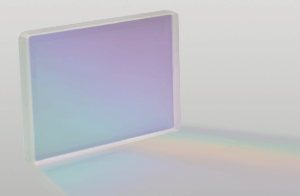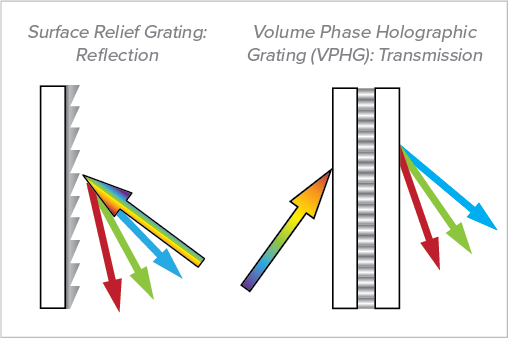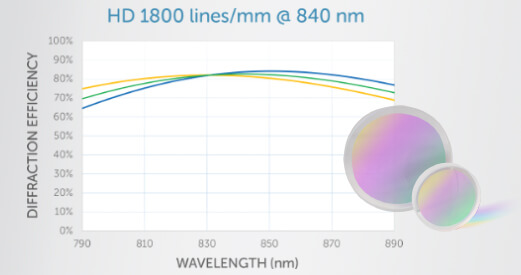 When you need to separate different wavelengths of light with superb spectral resolution in a compact, efficient manner, you might want to consider a diffraction grating.
When you need to separate different wavelengths of light with superb spectral resolution in a compact, efficient manner, you might want to consider a diffraction grating.
Diffraction gratings are widely used optical components featuring periodic structures that allow dispersion of light in a more compact, convenient format than a prism. They operate on the principle of interference to split multi-spectral light into its constituent wavelengths and, like a prism, disperse them spatially through a range of angles. The most common type of grating structure uses numerous parallel rulings on a surface in a manner similar to a series of slits, resulting in a superposition of waves that diffract light by wavelength, effectively separating it into its colors. This is not the only fundamental design type of diffraction grating, but it has become the widely-used standard for many applications.
There are many types of diffraction gratings, which can make the selection process tricky. This article is intended to act as a brief primer on the different types of diffraction gratings to help you select the right one for your application needs.
Reflection vs Transmission Diffraction Gratings
Reflection or transmission is one of the most fundamental distinctions in diffraction grating terminology. Essentially, a reflection grating diffracts light back into the plane of incidence while transmission gratings transmit dispersed light through. Due to the ability to better compensate for aberrations, optical systems made with transmission gratings have comparatively low alignment sensitivity, which can be a significant benefit for applications where minute alignment errors or temperature changes could wreak havoc on results. Consequently, transmission gratings are preferred over reflective components for many OEM applications.

Although important, reflection vs. transmission is not the final word in diffraction grating selection.
Diffraction Grating Design Principles
Gratings alter the phase of reflected or transmitted light based on their unique structural properties. A conventional surface relief grating is engineered by ruling a substrate material with equally-spaced grooves, creating the popular and easily recognizable ‘blazed’ surface. This is an expensive and time-consuming design process that may require multiple test gratings to be fabricated via diamond tooling before the final component is produced via replication. Ruled gratings also suffer from fairly high light scattering. Once manufactured, a ruled grating must be handled with care, as it cannot be cleaned without significant risk of damage. Dust, fingerprints, or other contamination adds to the inherent scatter of the grating over time.
Holographic gratings are designed to eliminate many of the errors associated with conventional surface relief components. Briefly, they are engineered by selectively exposing a substrate or photoreactive material on the substrate to a laser generated optical interference pattern of outstanding uniformity. This action then ‘writes’ a periodic structure into the chosen medium. Holography is now the gold-standard manufacturing technique for diffraction gratings. Learn more about the advantages of VPH gratings.

But we can extend the different types of diffraction gratings further to discuss the new and emerging manufacturing techniques for holographic gratings. Etched-in relief gratings comprised of fused silica and volume phase holographic (VPH) diffraction gratings, for instance, are two radically different design paradigms for modern optical systems. While both offer significantly higher efficiency than ruled gratings, VPH grating technology offers the optical engineer more design options to achieve the desired efficiency profile.
Selecting a Diffraction Grating
Choosing a diffraction grating comes down to several key interlinked performance factors, including:
- Efficiency: Diffraction grating efficiency is usually expressed as the percentage of incident light converted into the desired order as a function of wavelength, with most conventional gratings yielding asymmetric efficiency curves over the total wavelength range.
- Resolving power: The resolving power of a diffraction grating defines its ability to separate two wavelengths spatially and is determined primarily by the grating’s periodic structure.
- Wavelength range: A diffraction grating’s spectral range concerns the region of electromagnetic radiation that it can effectively disperse, which is likewise characteristic of the structure.
Choosing Diffraction Gratings with Wasatch Photonics
Wasatch Photonics is one of the industry’s leading suppliers of precision diffraction gratings for various optical systems. We appreciate the challenges of selecting the right optics for your application, and welcome the opportunity to design a grating to your specific needs. If you are looking for a new solution, why not contact us today to explore the possibilities?



